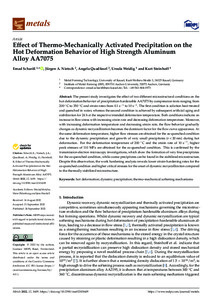| dc.date.accessioned | 2022-11-12T10:35:03Z | |
| dc.date.available | 2022-11-12T10:35:03Z | |
| dc.date.issued | 2022-09-26 | |
| dc.identifier | doi:10.17170/kobra-202211127101 | |
| dc.identifier.uri | http://hdl.handle.net/123456789/14243 | |
| dc.description.sponsorship | Gefördert durch den Publikationsfonds der Universität Kassel | |
| dc.language.iso | eng | |
| dc.rights | Namensnennung 4.0 International | * |
| dc.rights.uri | http://creativecommons.org/licenses/by/4.0/ | * |
| dc.subject | hot deformation | eng |
| dc.subject | dynamic precipitation | eng |
| dc.subject | thermo-mechanical softening mechanisms | eng |
| dc.subject.ddc | 620 | |
| dc.title | Effect of Thermo-Mechanically Activated Precipitation on the Hot Deformation Behavior of High Strength Aluminum Alloy AA7075 | eng |
| dc.type | Aufsatz | |
| dcterms.abstract | The present study investigates the effect of two different microstructural conditions on the hot deformation behavior of precipitation-hardenable AA7075 by compression tests ranging from 200 °C to 350 °C and strain rates from 0.1 s-¹ to 10 s-¹. The first condition is solution heat-treated and quenched in water, whereas the second condition is achieved by subsequent artificial aging and stabilization for 24 h at the respective intended deformation temperature. Both conditions indicate an increase in flow stress with increasing strain rate and decreasing deformation temperature. Moreover, with increasing deformation temperature and decreasing strain rate, the flow behavior gradually changes as dynamic recrystallization becomes the dominant factor for the flow curve appearance. At the same deformation temperature, higher flow stresses are obtained for the as-quenched condition due to the dynamic precipitation and growth of very small precipitates (r < 20 nm) during hot deformation. For the deformation temperature of 200 °C and the strain rate of 10 s-¹, higher peak stresses of 110 MPa are obtained for the as-quenched condition. This is confirmed by the transmission electron microscopy investigations, which show the formation of very fine precipitates for the as-quenched condition, while coarse precipitates can be found in the stabilized microstructure. Despite this observation, the work hardening analysis reveals lower strain-hardening rates for the as-quenched condition and higher critical stresses for the onset of dynamic recrystallization compared to the thermally stabilized microstructure. | eng |
| dcterms.accessRights | open access | |
| dcterms.creator | Scharifi, Emad | |
| dcterms.creator | Nietsch, Jürgen A. | |
| dcterms.creator | Quadfasel, Angela | |
| dcterms.creator | Weidig, Ursula | |
| dcterms.creator | Steinhoff, Kurt | |
| dc.relation.doi | doi:10.3390/met12101609 | |
| dc.subject.swd | Aluminiumlegierung | ger |
| dc.subject.swd | Thermomechanik | ger |
| dc.subject.swd | Deformation | ger |
| dc.subject.swd | Entfestigung | ger |
| dc.subject.swd | Dehnung | ger |
| dc.subject.swd | Fließverhalten | ger |
| dc.subject.swd | Temperaturverhalten | ger |
| dc.type.version | publishedVersion | |
| dcterms.source.identifier | eissn:2075-4701 | |
| dcterms.source.issue | Issue 10 | |
| dcterms.source.journal | Metals | eng |
| dcterms.source.volume | Volume 12 | |
| kup.iskup | false | |
| dcterms.source.articlenumber | 1609 | |


